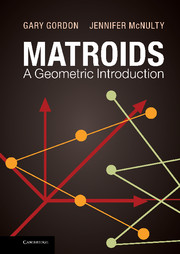2 - Cryptomorphisms
Published online by Cambridge University Press: 05 November 2012
Summary
Chapter 1 provided an introduction to matroids via a glimpse at several prototypes and their properties. This chapter will give the formal definitions and some of the basic results we will need for the rest of the book.
One of the most attractive features of matroids is the plethora of equivalent definitions. Borrowing from linear algebra, we defined a matroid in terms of independent sets in Chapter 1. In this chapter, we continue in this vein and give an equivalent definition in terms of bases. Graph theory motivates alternate formulations of matroids in terms of circuits and cocircuits, while closed sets, closure and hyperplanes come from geometry. We will tie these disparate concepts together using the rank function. There are many additional ways to define a matroid; we'll discuss some of them in the chapter and the exercises.
Each formulation (or reformulation) of the definition of a matroid will require a finite, ground set E and a family of subsets of E or a function defined on the power set 2E. These subsets and functions will satisfy various axioms, and each set of axioms will have one or two easy conditions and one more substantial axiom that characterizes a matroid property.
The central idea of this chapter is that these formulations are logically equivalent, and it is instructive to explicitly convert one axiom system to another. For example, you might wonder how you could determine the independent sets from the bases, or – if you were told the rank of any subset of the matroid, but nothing else – could you still figure out the independent sets? We'll describe a method, called a cryptomorphism, for converting from one system to another.
- Type
- Chapter
- Information
- Matroids: A Geometric Introduction , pp. 39 - 99Publisher: Cambridge University PressPrint publication year: 2012

